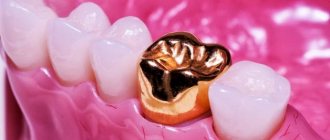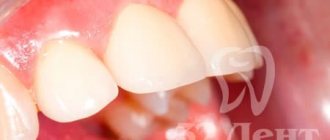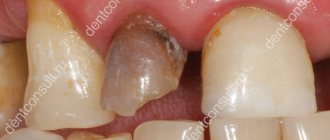“ – Doctor, the crown on my tooth is loose, what should I do?
” This question is not uncommon in the dental office. Patients do not always understand why, instead of simply fixing the crown, the doctor prescribes an examination.
The orthopedist’s task is not just to fix the prosthesis, but to find out the reason why the crown is loose after installation.
Without an examination, it is impossible to make an accurate diagnosis, and if the cause is not eliminated, the problem will arise again and again.
What causes the crown to become loose?
Part of the dental examination is taking an anamnesis, especially if the denture is several years old and you came to a different doctor with a problem than the one who installed it.
The fact is that there are objective reasons for the loosening of crowns.
Dental cement changes its structure over time, and its adhesive (adhesion-promoting) properties are lost. The crowns on the front teeth become loose especially often, because each bite leads to less grip.
Another objective reason is gum recession (loss). With age, the gums sag, covering the roots less and less. A gap forms between the restoration and the gum, where food debris gets in and colonies of bacteria begin to flourish. They destroy hard tissues, the stump becomes smaller, and the prosthesis cannot stay on it.
Therefore, dentists recommend replacing crowns regularly. Most often, a metal-ceramic crown wobbles, because the stump is heavily ground down for it, and the structure itself is massive, with thick walls. The service life of such crowns is the shortest: 5-7 years
. The stronger the material, the thinner the crown, the better the fit, and therefore the longer the service life. Therefore, ceramic restorations and products made from zirconium dioxide can be worn for decades.
But there are other reasons why the crown on a tooth becomes loose.
- Incorrect preparation
The stump for prosthetics must meet certain requirements: slightly taper towards the lower edge, be at least 3 mm in height (4 mm for molars).
If the doctor did excessive grinding, then the crown will slide off the tooth like a slide, even in the presence of cement. There should be a minimum gap between the tooth stump and the walls of the crown. The smaller the gap, the more reliable it is.
Perhaps the tooth was initially short and the doctor did nothing to grow it to the desired size. You can glue the crown, but it will still fall off. The higher the tooth, the better the crown is fixed on it.
The solution to the problem is to build up the stump with composite materials or inlays.
- Problems with cement
Dental materials are expensive and some clinics buy cheap materials from unknown manufacturers. Patients suffer from such savings.
Another case is when the cement is of high quality, but the technology for its preparation has been violated. The adhesive properties of such cement will not be good enough for the prosthesis to last for several years.
When re-prosthetics or re-installation, it is necessary to maintain proportions when mixing cement and use a quality product.
- Violation of manufacturing technology
The quality of the crown depends not only on the orthopedist, but also on the technician who makes it. A qualified technician follows all the requirements for the manufacturing process and always carries out sandblasting. It makes the inner surface rough, and this increases adhesion (adhesion).
Compliance with manufacturing requirements will improve the quality of the prosthesis and extend its service life.
- Loss of hard tissue
Before prosthetics, teeth are often depulped and the nerve (pulp) is removed. Therefore, during caries, the tooth under the crown does not hurt, but it can be destroyed. If caries destroys most of the hard tissues, the crown will begin to wobble, because the volume of the stump will decrease.
The patient himself can understand that the tooth under restoration is inflamed only by the smell from under the crown. In dentistry, for diagnosis, a targeted photograph is used, in which the lesion is visible. After treatment, the orthopedist will build up the stump or use microprostheses before installing the crown. If the tooth cannot be saved, it will be removed. The dentition can be restored with a bridge or implant. Implantation will avoid grinding down adjacent teeth and prevent bone loss. The bridge cannot stop atrophy.
Why does pain occur after installation?
The causes of pain with a pin installed cannot be identified on your own. If you notice that after implantation the tooth area begins to hurt, be sure to make an appointment with a doctor.
Pain occurs due to unprofessional or erroneous actions of the dentist.
- The pin is set too deep. The pain is felt during physical impact (for example, chewing) and has an aching character.
- During installation, the dental canal was cleaned with errors, and the walls of the tooth were damaged.
- The filling material has not completely filled the root canal. It could also simply extend beyond the apical foramen.
- When a fragment or several fragments are found in the canal belonging to endodontic instruments.
- In case of poorly performed disinfection of the canal during the procedure.
There are many reasons why pain occurs after insertion of a pin.
Important ! When installing the pin, the doctor requires high concentration.
During cleaning, it is necessary to use all the necessary instruments and identify the position of the apical foramen. To monitor the condition, an additional x-ray is prescribed.
In addition to incorrectly performed medical procedures, there may be other causes of painful sensations.
Normally, aching pain in a tooth can last up to several days; over time it subsides and disappears completely. Sometimes the pain is associated with an allergy, when the body does not accept the material from which the pin is made. In such cases, x-rays usually show the real picture.
Some discomfort after the procedure is normal.
If pain is not observed immediately after the intervention, but after a long period, for example, after several years, then the reasons that led to its occurrence may be as follows.
- Failure to maintain proper oral hygiene.
- Minor damage to tooth tissue (usually occurs due to biting nuts and other hard objects, opening lids with teeth, etc.).
- Periodontal inflammation.
- The appearance of cysts on the roots of teeth.
- Serious tissue damage.
Video - Dentist about pain in a tooth without a nerve
- How long does it take for drugs to leave the body?
Reasons for loosening of the crown on the pin and inlay
The reason that the crown on the pin began to wobble depends on cementation and correct installation:
- When bonding with dental cement, the quality of the material is of great importance. Its task is to seal the gap between the tooth, the pin and the crown.
- Incorrect installation of the pin (fiberglass pin) in the channel. To use a post, it is important that most of the tooth is preserved. The pin is responsible for stability, but the crown is held on the tooth. If the pin is poorly secured or the tooth is severely damaged, the denture will wobble.
The inlay, unlike the pin, consists of two parts, the pin itself and an element that replicates the tooth. The crown on the inlay is loose if:
- de-cementing occurred;
- parts of the tab have become disconnected.
Re-prosthetics in cases where pins and inlays are used will take longer. It is necessary to install microprostheses in compliance with the technique, correct the defects that led to the loss, and then install a new crown. Attempts to fit a microprosthesis to an old restoration will lead to the fact that the entire structure will have to be changed again.
How to choose a pin, by what criteria
Metal pins
There are several criteria for choosing pins, but this is definitely not a price indicator. The decision to use one design or another is made by a specialist.
The main factors influencing the choice of pin:
- extent of tooth damage, condition of dentin;
- root canal parameters;
- level of load on the tooth being restored;
- immersion depth;
- the expected or required service life of the structure;
- channel wall thickness;
- condition of the roots, dentin around the causative tooth;
- material used in the production of rods.
Reasons for loosening of the crown on an implant
If the crown is fixed to the adapter (abutment) with cement, then the most common reason for loosening is poor quality of the material. With screw fastening, the prosthesis is fixed with special screws onto the implant, which acts as a root. This method is considered more reliable compared to cement fixation. But the fastening is subject to load from different sides and the screw may loosen.
The doctor can easily strengthen a loose crown simply by tightening the screw. Screw fastening is more expensive, but as a result, the crown does not have to be replaced every time it becomes loose. The dentist can better see the progress of implant healing and work with screw-based dentures much easier.
What to do if the crown on the implant is loose? You must consult a doctor immediately. This may be a symptom of implant rejection or inflammation of the tissue around it. In such cases, special treatment is necessary.
Rehabilitation period
Despite the fact that the operation of implanting a pin is an ordinary procedure, after the manipulations the patient must follow some rules.
- After the pinning operation, the doctor prescribes antibiotics and, if necessary, other drugs. All instructions must be followed according to the scheme, otherwise the risk of developing an inflammatory process will increase, which will lead to rejection of the structure.
- oral hygiene procedures, Brushing your teeth should be done twice a day.
- The menu is designed to include soft food dishes. To do this, during cooking, it is better to grind the food with a grater or blender.
- You should forget about toothpicks , at least for a while until the wound heals. Any mechanical loads can provoke rejection of the pin from the soft tissues.
Temporary crowns
The implantation process involves a fairly long (depending on the protocol) waiting period for the artificial root to take root. During this time, the patient is fitted with temporary prostheses.
Temporary crowns are made from inexpensive materials that do not have sufficient rigidity. If you don't take good care of them, infection can easily get to the tooth. Therefore, in most cases, the reason why a temporary crown on an implant becomes loose is non-compliance with the rules of care and excessive chewing load.
Contraindications
Pins help restore a beautiful smile in many, even very difficult cases. However, there are still limitations to the implantation of the structure:
- when a cyst or granuloma is detected;
- if an inflammatory process in dentin is detected;
- for root canal pathologies (curvature, blockage, etc.);
- when the canal walls are very thin.
Experts do not recommend performing the procedure of implanting a rod during pregnancy. But this issue is resolved by postponing the operation for several months.
General overview
The pin is an artificial reinforcing element made in the form of a thin rod. The product is intended to extend the life of the restored unit. The rod is attached by insertion into the pulpless root passage.
Teeth with the nerve removed become brittle and susceptible to deformation due to increased loss of minerals. The pin acts as a support for fixed prosthetic structures. The product is implanted when reinforcement, replantation, bridge fixation, splinting for periodontal disease and other restoration procedures are required.










